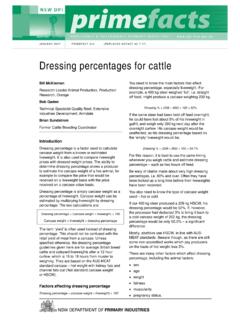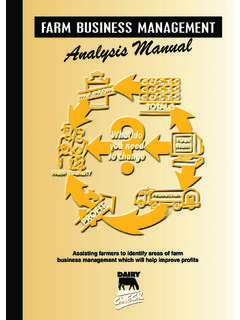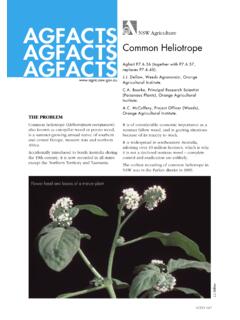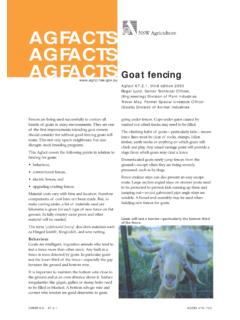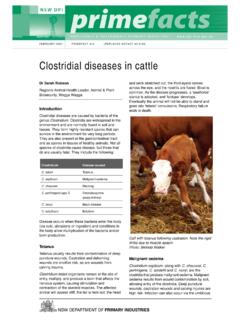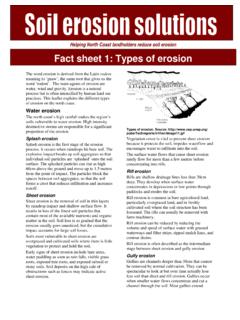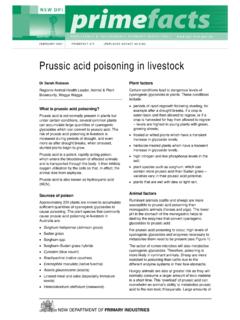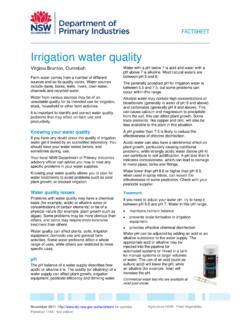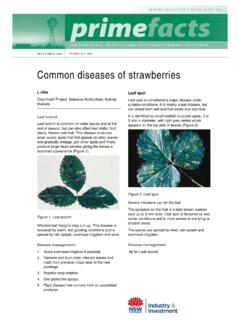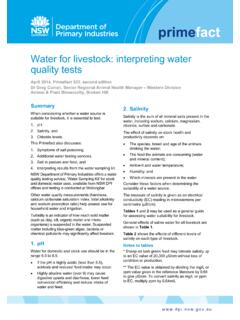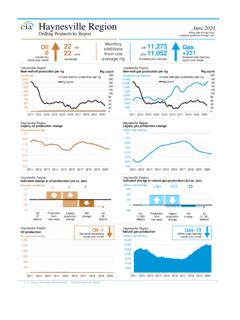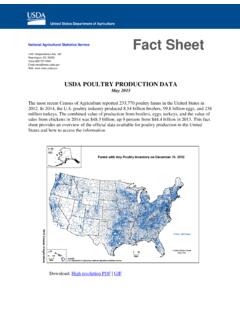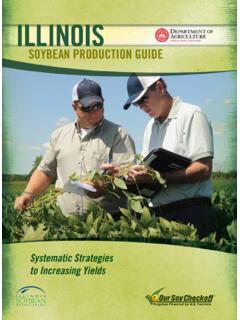Transcription of Forage brassicas - quality crops for livestock production
1 AGFACTS AGFACTS AGFACTS INTRODUCTION Forage brassicas are members of the brassica family, which includes radish, turnip, swedes, broccoli, brussel sprouts, cauliflower and cabbage. Canola is an oilseed brassica which is not really suitable for grazing by livestock . The Forage brassicas are mostly grown in cool temperate parts of NSW such as the tablelands and Monaro regions. They are commonly sown in spring and late summer in these regions to provide high quality feed in summer and Forage brassicas quality crops for livestock production Agfact , first edition 2002 Linda Ayres, District Agronomist, Orange Bruce Clements, District Agronomist, Bathurst autumn when pasture quality is often low, or autumn and winter when pasture quantity is limited. Forage brassicas can provide quick and abundant feed, with high digestibility, energy, and protein.
2 The crude protein content of brassica leaves ranges from 15 to 25 percent and that of turnips and swede bulbs from 9 16 percent. The metabolisable energy content ranges from 11 14MJ ME/kg DM. Forage brassicas can produce excellent livestock weight gains, for example 150 250 g/hd/day Forage brassicas can provide quick and abundant feed, with high digestibility, energy, and protein. (Photo: L Ayres) AGDEX 124/20 ORDER NO. for lambs and kg/hd /day for growing cattle are common. The relatively low cost of establishing Forage brassicas also makes them an attractive option for quick feed. Forage brassicas can also form a useful part of a pasture improvement program. Weeds that are competitive to an autumn sown pasture are controlled by the paddock preparation for brassicas . Seedset of broadleaf and grass weeds are greatly reduced, leaving the paddock in an ideal condition for pasture or crop sowing.
3 The brassica crop will also provide significant quantities of quality feed rather than the paddock being left fallowed. A spring sown brassica crop will leave a paddock in an ideal condition for direct drilling pasture in the following autumn. brassica crops can also reduce the incidence of soil-borne plant diseases. brassica crops contain naturally occurring chemicals called glucosinolates. These chemicals break down in the soil to produce compounds that inhibit the growth of disease producing organisms such as the take-all fungus, which is regarded as one of the most serious root diseases of wheat. They also reduce the incidence of nematodes. While the level of these biofumigants varies between brassica types, all brassicas will deliver some benefit. TYPES OF Forage brassicas The Forage brassicas can be divided into 5 main types: Forage rape ( ) Leafy turnips or Forage brassica hybrids ( spp.)
4 Kale or Chou Moellier ( ) Turnips ( ) Swedes ( The five types of Forage brassicas differ in their characteristics and uses. In general the differences are: Forage rape Forage brassicas are also referred to as rape . Most types have a stringent grazing management requirement and must reach maturity before being grazed. Maturity is indicated by a change in leaf colour to a purplish or bronze colour that occurs 10 14 Forage rape (Photo L Ayres) Leafy turnip (Photo L Ayres) 2 weeks after sowing. Grazing prior to this is the major cause of several livestock health problems (see section on animal health issues). It is advisable to check with your local agronomist or seed company representative as some of the newer Forage rapes on the market are more flexible and can be grazed early and late whilst maintaining quality .)
5 Leafy turnips or Forage brassica hybrids Hybrids are crosses between various species of the brassica family. Most hybrids are crosses with turnips and various forms of oriental vegetables. Grazing leafy turnips can commence earlier than rapes (6 10 weeks), without waiting for the leaf to turn a characteristic br onze or purple colour. Leafy turnips can vary in their ability to maintain palatability and leaf quality with age. Kales Kale is also known as Chou Moellier. Kale is the tallest growing of all Forage brassicas , and is slower to mature than the hybrid brassicas . It will produce large quantities of leaf and stem which is utilised mostly by cattle. Most kales have a characteristic winter habit, and a greater cold tolerance than other brassicas . Turnips Both turnip leaf and bulbs are utilised by grazing animals.
6 The turnip bulb is a large storage organ that develops in the first year. Turnip feed dry matter is around 60% bulb and 40% leaf, depending on the size/age and variety of turnip. Turnips are best grazed once at maturity (10 16 weeks). Regrowth is possible from a light first grazing if the leaf growing points attached to the bulb are not damaged. Turnips suffer less from insect attack Turnip bulbs can be round or tankard shaped. (Photo: Stephen Pasture Seeds Pty Ltd) than other Forage brassicas , however they are not as drought tolerant. Swedes Swedes are most commonly sown in late spring/ early summer in areas with cold winters and moist summers. They require higher rainfall than turnips. Swedes have a larger bulb than turnips and are slower to mature (20 24 weeks). Swedes are better than turnips at maintaining bulb quality over winter.
7 Grazing normally commences during winter and the crop is usually only grazed once. Swedes can be sown in a mixture with turnips to spread grazing times over several months. Note: V arieties currently available are listed in the supplement to this Agfact. PADDOCK SELECTION AND PREPARATION Soils brassicas can be grown in a wide range of soil types, but for best performance choose paddocks with good soil fertility and depth. Avoid shallow soils and waterlogged areas. A soil test should be taken to determine soil acidity and fertility for nutrient and lime requirements. In highly acidic soils pH (CaCl2) less than , lime should be applied well before sowing brassicas . Paddock selection Crop area needs to be considered in relation to the number and type of livestock managed on the property. Some paddocks are sown to Forage brassicas as part of the pasture establishment process to reduce weed problems and prepare paddocks for subsequent pasture sowing.
8 If possible avoid sowing brassicas on to westerly aspects as these do not hold as much moisture during the summer as other aspects. Sowing into paddocks which have a greater ability to retain moisture will ensure more water is available for crop growth during summer. Pre-sowing Preparation Initial ploughing or spray fallowing should be carried out preferably two months prior to sowing to control weeds and conserve soil moisture. Early workings will stimulate weed germination, and further cultivations or 3 requirements. Sowing times Grazing times chemical control measure will ensure the weed problems are reduced. brassica seeds are very small, so a fine but firm seedbed is desirable. Avoid excessive ploughing as this can often cause a crust to develop on the surface of some soils, which can be detrimental to seedling establishment.
9 Direct drilling is sometimes used but results can be variable. Successful establishment depends on good seedbed preparation, weed and pest control, soil type and rainfall following sowing. SOWING Sowing time The type of brassica being sown and when the feed is required will determine sowing time (see Table 1). For summer feed most Forage brassicas are planted early enough in spring (September/October) to capitalise on stored winter soil moisture and to capture reliable spring rainfall. In some environments favourable conditions may allow later sowings. Late sowings become highly dependent on unreliable summer rains and storms, and also make the crops more prone to aphid attack. Traditionally, tur nips and kales are sown later, often in December, January, and February on summer rains to produce late autumn/ winter feed.
10 Seeding rate Generally, rape and kale crops are sown at 3 5 Table 1. Seasonal sowing guide for Forage brassicas kg/ha, and turnips and swedes at kg/ha. The higher rates should be used if sowing into rougher seedbeds or if crops are irrigated. One kilogram of Forage rape seed per hectare should provide enough plants to achieve 8 10 plants per square metre. Higher seeding rates may be required if direct drilling or broadcast sowing to compensate for a slight yield reduction or a poor germination. High rates for turnips often result in small, spindly turnip bulbs that can choke cattle. Forage brassicas can be successfully undersown with pastures. brassica sowing rates should be reduced by half to two thirds when undersowing pastures. Sowing depth brassica seeds are very small so to ensure maximum germination, sow no deeper than 2 cm into a firm, moist seedbed.
